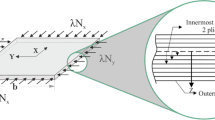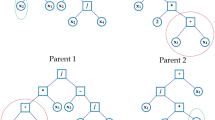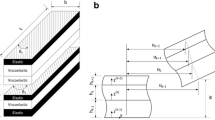Abstract
In this paper a new hybridised version of non-dominated sorting genetic algorithm (NSGA) is proposed to solve combinatorial optimisation problems associated with laminated composite structures. The proposed algorithm is used to optimise the design of hybrid laminated fibre composite skirt of solid rocket motor, subjected to a buckling strength constraint and an overstressing strength constraint under aerodynamic torque and axial thrust. The present investigations involve in determining the best laminate configuration to minimise the weight as well as cost of the skirt through multi-objective optimisation. Buckling strength and overstressing strength of the composite cylindrical skirt are analysed using classical laminate theory. Tsai-Wu failure criterion is employed to assess the first ply failure, and failure strength is described by an overstressing load level factor. The superiority of the proposed hybrid algorithm is demonstrated by comparing with the originally proposed NSGA algorithm. The studies presented in this paper clearly indicate that the proposed modification to the NSGA improves the convergence properties quite appreciably.






Similar content being viewed by others
References
Callahan KJ, Weeks GE (1992) Optimum design of composite laminates using genetic algorithms. Composites, Part B, Eng 2:149–160
Le Riche R, Haftka RT (1993) Optimization of laminate stacking sequence for buckling load maximisation by genetic algorithm. AIAA J 31(5):951–956
Bert CW (1997) Optimal design of composite material plates to maximise its fundamental frequency. J Sound Vib 50:229–237
Reiss R, Ramachandran S (1987) Maximum frequency design of symmetric angle-ply laminates. Compos Struct 100:476–487
Adali S (1995) Lay-up optimization of laminated plates under buckling loads. In: Turvey GJ, Marshall IH (eds) Buckling and post buckling of composite plates. Chapman & Hall, London
Venkataraman S, Haftka R (1999) Optimization of composite panels-a review. In: Proceedings of the American Society of Composites—14th annual technical conference, Fairborn, OH, pp 479–488
Deb K (2001) Multi-objective optimization using evolutionary algorithms. Wiley, New York
Messac A (1996) Physical programming: effective optimization for computational design. AIAA J 34(1):149–158
Sen P, Yang JB (1998) Multiple criteria decision support in engineering design. Springer, London
Chankong V, Haimes YY (1983) Multi-objective decision making theory and methodology, vol 4. Elsevier Science, New York
Kumar N, Tauchert TR (1992) Multi-objective desing of symmetrically laminated plates. Journal of Mechanical Design 114(4):620–625
Adali S, Walker M, Verijenko VE (1996) Multi-objective optimization of laminated plates for maximum pre buckling, buckling and post buckling strengths using continuous and discrete ply angles. Composite Structures 35(1):117–130
Walker M, Reiss T, Adali S (1997) Multi-objective design of laminated cylindrical shells for maximum torsional and axial buckling loads. Comput Struct 62:237–242
Walker M, Smith R (2003) A technique for the multi-objective optimization of laminated composite structures using genetic algorithms and finite element analysis. Compos Struct 62:123–128
Zitzler E, Laumanns M, Thiele L (2001) SPEA2: Improving the strength Pareto evolutionary algorithm. Tech Rep 103, Computer Engineering and Networks Laboratory (TIK). Swiss Federal Institute of Technology (ETH), Zurich, Switzerland
Knowles J, Corne D (1999) The Pareto archived evolution strategy: a new baseline algorithm for multi-objective optimization. In: Proceedings of the 1999 congress on evolutionary computation. IEEE Press, Piscataway, pp 99–105
Deb K, Pratap A, Agarwal S, Meyarivan T (2002) A fast and elitist multi-objective genetic algorithm: NSGA-II. IEEE Trans Evol Comput 6(2):182–197
James FF (1970) Structural design and analysis of filament wound rocket motor cases. Technical Report, AD876829
Maheshwari M, Grover RL (1983) Development of advanced composite rocket motor case for internal and external load environments. Technical Report, AIAA-Paper-84-1352
Hoffman HJ (1983) Kevlar rocket motor cases. CPIA Report CPTR-83-21
Peters ST, Humphrey WD, Foral RF (1999) Filament windings-composite structure fabrication. SAMPE Press, Covina
Francis M (1993) Design, manufacture and test of composite case for ERINT-1 solid rocket motor. In: AIAA/SAE/ASME/ASEE 19th joint propulsion conference and exhibit
Nshanian YS, Pappas M (1983) Optimal laminated composite shells for buckling and vibration. AIAA J 21:430–437
Onoda J (1985) Optimal laminate configurations of cylindrical shells for axial buckling. AIAA J 23:1093–1098
Sun G, Hansen JS (1988) Optimal design of laminated-composite circular-cylindrical shells subjected to combined loads. J Appl Mech 55:136–142
Sun G (1989) A practical approach to optimal design of laminated cylindrical shells for buckling. Compos Sci Technol 36:243–253
Zimmermann R (1995) Quick optimum buckling design of axially compressed, fiber composite cylindrical shells. AIAA J 33:1993–1995
Xie YJ, Yan HG, Liu ZM (1996) Buckling optimization of hybrid-fiber multilayer-sandwich cylindrical shells under external lateral pressure. Compos Sci Technol 56:1349–1353
Walker M, Reiss T, Adali S (1997) Minimum weight design of composite hybrid shells via symbolic computation. J Franklin Inst 334B:47–56
Tripathy B, Rao KP (1993) Stiffened composite axisymmetric shells-optimum layup for buckling by ranking. Comput Struct 46:299–309
Sun G, Hansen JS (1998) Optimal design of laminated composite circular-cylindrical shells subjected to combined load. J Appl Mech 55:136–142
Walker M, Reiss T, Adali S (1997) Multi-objective design of laminated cylindrical shells for maximum torsional and axial buckling loads. Comput Struct 62:237–242
Smerdov AA (2000) A computational study in optimum formulations of optimization problems on laminated cylindrical shells for buckling I. Shells under axial compression. Compos Sci Technol 60:2057–2066
Smerdov AA (2000) A computational study in optimum formulations of optimization problems on laminated cylindrical shells for buckling II. Shells under external pressure. Compos Sci Technol 60:2067–2076
Adali S, Verijenko VE, Richter A (2001) Minimum sensitivity design of laminated shells under axial load and external pressure. Compos Struct 54:139–142
Rama Mohan Rao A, Lakshmi K (2009) Multi-objective optimal design of hybrid laminated composite structures using scatter search. J Compos Mater 43(20):2157–2181
Rama Mohan Rao A, Lakshmi K (2011) Discrete hybrid PSO algorithm for design of laminate composites with multiple objectives. J Reinf Plast Compos 30(20):1703–1727
Lakshmi K, Rama Mohan Rao A (2012) Multi-objective optimal design of laminate composite shells and stiffened shells. Struct Eng Mech 43(12):771–794
Perera R, Fang SE, Ruiz A (2010) Application of particle swarm optimization and genetic algorithms to multiobjective damage identification inverse problems with modeling errors. Meccanica 45:723–734
Ghashochi Bargh H, Sadr MH (2012) Stacking sequence optimization of composite plates for maximum fundamental frequency using particle swarm optimization algorithm. Meccanica 47:719–730
Rama Mohan Rao A, Shyju PP (2011) A new meta-heuristic algorithm for multi-objective optimal design of hybrid laminate composite structures. Comput-Aided Civ Infrastruct Eng 25:149–170
Rama Mohan Rao A, Lakshmi K (2012) Optimal design of stiffened laminate composite cylinder using a hybrid SFLA algorithm. J Compos Mater 46(24):311435674. doi:10.1177/0021998
Rama Mohan Rao A, Arvind N (2005) A scatter search algorithm for stacking sequence optimization of laminated composites. Compos Struct 70(4):383–402
Lahanas M, Baltas D, Zamboglou N (2003) A hybrid evolutionary algorithm for multi-objective anatomy-based dose optimization in high-dose-rate brachytherapy. Phys Med Biol 48:399–415
Gao X, Chen B, He X, Qiu T, Li J, Wang C, Zhang L (2008) Multi-objective optimization for the periodic operation of the naphtha pyrolysis process using a new parallel hybrid algorithm combining NSGA-II with SQP. Comput Chem Eng 32:2801–2811
Deb K (2008) A robust evolutionary framework for multi-objective optimization. In: Proceedings of the 10th annual conference on genetic and evolutionary computation (GECCO’08), 12–16 July, Atlanta, Georgia, USA. ACM, New York, pp 633–640
Li M, Zheng J, Wu J (2008) Improving NSGA-II algorithm based on minimum spanning tree. In: Lecture notes in computer science. LNCS, vol 5361. Springer, Berlin, Heidelberg, pp 170–179
Ghomsheh V, Khanehsar MA, Teshnehlab M (2007) Improving the non-dominate sorting genetic algorithm for multi-objective optimization. In: Inter. conf. on computational intelligence and security workshops (CISW 2007), Heilongjiang, China, pp 89–92
Johnson DS, McGeoch LA (1997) The traveling salesman problem: a case study. In: Aarts EH, Lenstra JK (eds) Local search in combinatorial optimization. Wiley, Chichester, pp 215–310
Jones RM (1975) Mechanics of composite materials. McGraw-Hill, New York
Agarwal BD, Broutman LJ (1990) Analysis and performance of fiber composites, 2nd edn. Wiley, New York
Timoshenko SP, Gere JM (1961) Theory of elastic stability, 2nd edn. McGraw-Hill, New York
Vinson JR (1993) The behaviour of shells composed of isotropic and composite materials. Kluwer, Dordrecht
Grosset L, Venkataraman S, Haftka RT (2001) Genetic optimization of two-material composite laminates. In: Proceedings, 16th ASC technical meeting, Blacksburg, VA, September
Todoroki A, Sasai M (1999) Improvement of design reliability for buckling load maximization of composite cylinder using genetic algorithm with recessive-gene-like repair. JSME Int J Ser A 42(4):530–536
Acknowledgements
This paper is being published with the permission of the Director, CSIR-SERC, Chennai. This research is supported, in part, by Naval Research Board, New Delhi under the grant DRND/05/4003/NRB/78.
Author information
Authors and Affiliations
Corresponding author
Rights and permissions
About this article
Cite this article
Lakshmi, K., Rama Mohan Rao, A. Multi-objective optimal design of laminated composite skirt using hybrid NSGA. Meccanica 48, 1431–1450 (2013). https://doi.org/10.1007/s11012-012-9676-5
Received:
Accepted:
Published:
Issue Date:
DOI: https://doi.org/10.1007/s11012-012-9676-5




